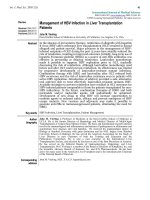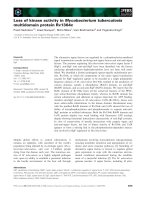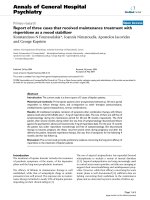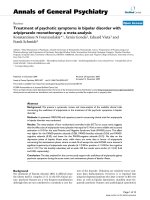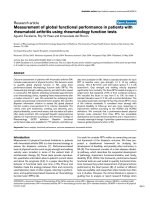Báo cáo y học: "Measurement of endotoxin activity in critically ill patients using whole blood neutrophil dependent chemiluminescence" pps
Bạn đang xem bản rút gọn của tài liệu. Xem và tải ngay bản đầy đủ của tài liệu tại đây (117.44 KB, 8 trang )
Critical Care August 2002 Vol 6 No 4 Marshall et al.
Research
Measurement of endotoxin activity in critically ill patients using
whole blood neutrophil dependent chemiluminescence
John C Marshall
1
, Paul M Walker
2
, Debra M Foster
3
, David Harris
4
, Melanie Ribeiro
4
, Jeff Paice
5
,
Alexander D Romaschin
6
and Anastasia N Derzko
7
1
Director of Research , Medical/Surgical Intensive Care Unit, University Health Network, Toronto, Ontario, Canada
2
President and Chief Executive Officer, Spectral Diagnostics and Sepsis Inc, Toronto, Ontario, Canada
3
Director Clinical Trials, Spectral Diagnostics and Sepsis Inc, Toronto, Ontario, Canada
4
Research Associate, Spectral Diagnostics and Sepsis Inc, Toronto, Ontario, Canada
5
Research Scientist, Spectral Diagnostics and Sepsis Inc, Toronto, Ontario, Canada
6
Associate Professor, Department of Pathobiology and Laboratory Medicine, University Health Network, Toronto, Ontario, Canada
7
Data manager, Spectral Diagnostics and Sepsis Inc, Toronto, Ontario, Canada
Correspondence: Dr John Marshall,
Introduction
Lipopolysaccharide (endotoxin) from the cell wall of Gram-
negative bacteria is a potent trigger for the release of host-
derived inflammatory mediators of sepsis, including proteins,
free radicals and bioactive lipids [1–3]. A single intravenous
bolus of Escherichia coli endotoxin given to healthy humans
evokes many of the same responses (fever, tachycardia,
tachypnoea and leukocytosis) that characterize Gram-nega-
tive infection [4].
EAA = endotoxin activity assay; ICU = intensive care unit; LAL = limulus amoebocyte lysate; SIRS = systemic inflammatory response syndrome.
Abstract
Background Lipopolysaccharide (endotoxin) from the cell wall of Gram-negative bacteria is a potent
trigger for the release of host-derived inflammatory mediators. The relationship between endotoxaemia,
Gram-negative infection and the clinical syndrome of sepsis has been difficult to establish, in part
because of the limitations of available endotoxin assays.
Methods We performed an observational cohort study in critically ill patients in the medical/surgical
intensive care unit (ICU) of a tertiary care hospital. Whole blood endotoxin levels on the day of ICU
admission were measured using a novel chemiluminescent assay – the endotoxin activity assay (EAA) –
and the chromogenic modification of the limulus amoebocyte lysate (LAL) assay.
Results We studied 74 consecutive admissions. Endotoxin levels were higher in patients with a diagnosis
of sepsis (470 ± 57 pg/ml) than in patients admitted with a diagnosis other than sepsis
(157 ± 140 pg/ml; P < 0.001). Endotoxaemia was significantly associated with Gram-negative infection
(P < 0.05); no patient with a Gram-negative infection had an endotoxin level below 50 pg/ml. White blood
cell counts of patients with EAA-detected endotoxaemia were significantly higher (15.7 ± 9.1 × 10
9
cells/l
for endotoxaemic patients versus 10.8 ± 6.2 × 10
9
cells/l for patients without endotoxaemia; P < 0.05).
Conclusion Endotoxaemia is associated with Gram-negative infection from any source, and with a
diagnosis of sepsis and leukocytosis. These correlations were not apparent using the LAL method. The
EAA may be a useful diagnostic tool for the investigation of invasive Gram-negative infection and
incipient sepsis.
Keywords critical illness, endotoxaemia, endotoxin assay, infection, sepsis
Received: 21 February 2002
Accepted: 22 February 2002
Published: 2 May 2002
Critical Care 2002, 6:342-348
This article is online at />© 2002 Marshall et al., licensee BioMed Central Ltd
(Print ISSN 1364-8535; Online ISSN 1466-609X)
Available online />Endotoxaemia has been detected in a variety of disorders,
including sepsis [5–7], liver disease [8,9] and vascular
disease [10], and in patients who have sustained trauma [11]
or who have undergone cardiopulmonary bypass [12]. Even
within aetiologically homogeneous populations of patients
with sepsis, there is considerable variability in the prevalence
of endotoxaemia and its association with important clinical
outcomes [5–7]. Inability to detect endotoxaemia reliably in
the clinical setting has impeded assessment of its precise
role in inflammatory responses in critically ill patients [13].
A minority of patients with clinical sepsis are bacteraemic by
conventional blood culture methods [6,14,15], and only
30–60% of bacteraemic patients develop fever and evidence
of organ dysfunction [16]. Moreover, the association of endo-
toxaemia with Gram-negative bacteraemia is poor, perhaps in
part because of the low sensitivity and specificity of blood
cultures. Antibiotic administration may further confound
culture results by triggering endotoxin release from dying
organisms [17].
Measurement of endotoxin in biological fluids is notoriously
difficult [18]. The most widely used method – the chro-
mogenic modification of the limulus amoebocyte assay (LAL)
[19,20] – permits detection of endotoxin in picogram quanti-
ties and has become the standard assay system used to
detect endotoxin contamination in pharmaceutical manufac-
turing. Plasma proteins can interfere with the assay, making it
less reliable in biological fluids. Moreover, the limulus coagu-
lation cascade can be triggered by fungal products, render-
ing the assay relatively nonspecific. A recent report [21]
documented an association between the chromogenic LAL
and fungaemia, but found a negative correlation with Gram-
negative bacteraemia.
We have developed an alternative technique for detecting
endotoxin in whole blood based on the detection of
enhanced respiratory burst activity in neutrophils following
their priming by complexes of endotoxin and a specific anti-
endotoxin antibody [22]. The EAA shows excellent perfor-
mance characteristics in recovering endotoxin from spiked
samples and can be performed within 30 min, using less than
100 µl whole blood. We therefore undertook the present
study to compare the LAL assay with the EAA, to determine
the prevalence of endotoxaemia in a population of patients
admitted to an ICU, to define its association with invasive
infection, and to evaluate the association of endotoxaemia at
ICU admission with clinical outcomes.
Patients and methods
We studied an inception cohort of 74 consecutive patients
admitted to the medical-surgical ICU of the Toronto Hospital –
a 900-bed tertiary care referral center. The study protocol
was reviewed and approved by the Committee for Research
on Human Subjects (The Toronto Hospital), and need for
informed consent was waived. Excluded patients included
those who were admitted on the weekend, who had no arter-
ial line, or who had a terminal prognosis.
Data collection and study definitions
Comprehensive clinical and laboratory data were collected on
the day of ICU admission. Survival status was assessed at
30 days, and at ICU and hospital discharge. Admission multiple
organ dysfunction score [23] and Acute Physiology and
Chronic Health Evaluation II score [24] were calculated. Sys-
temic inflammatory response syndrome (SIRS) was defined in
accordance with the criteria of the American College of Chest
Physicians/Society of Critical Care Medicine Consensus Con-
ference [25]. Sepsis was defined as SIRS plus infection. Infec-
tion was diagnosed by the presence of microorganisms
invading an otherwise sterile body fluid or site. Coagulase-neg-
ative staphylococci grown in one of two bottles from a blood
culture was considered a contaminant. Blood for endotoxin
assay was collected within 12 hours of admission in endotoxin-
free tubes, with EDTA as an anticoagulant. Aliquots of platelet-
poor plasma were stored at –70°C for subsequent LAL assay
in pyrogen-free tubes. Endotoxin assays were compared with
cultures drawn within 8 hours of the endotoxin sample.
Hypotension was defined as a systolic blood pressure below
90 mmHg for at least 1 hour, despite adequate filling pres-
sures (pulmonary artery wedge pressure >12 mmHg), or as
administration of an intravenous fluid bolus greater than
500 ml or the use of inotropic support (dopamine > 5 µg/kg
per min, or phenylephrine, epinephrine or norepinephrine at
any dose to maintain systolic blood pressure > 90 mmHg).
Assay of endotoxin by endotoxin activity assay
The EAA assay is described in detail elsewhere [22]. Briefly,
a 2-ml sample of whole blood was drawn through an
indwelling arterial line into an endotoxin-free K3EDTA blood
collection tube (Vacutainer systems; Becton Dickinson,
Franklin Lakes, NJ, USA). Samples were immediately trans-
ported to a laboratory adjacent to the ICU for assay. Blood
samples were maintained at room temperature and all
samples were assayed within 30 min of collection.
To assay levels of endotoxin, a 10 µl aliquot of whole blood
was placed in each of three tubes containing luminol buffer
(300 µl/tube). The control tube contained blood and buffer
only, whereas a positive control contained a maximum stimu-
latory concentration of endotoxin (2 ng/ml); the final tube con-
tained the test sample. All three tubes were incubated at
37°C for 5 min and assayed in triplicate. Chemiluminescence
was initiated by the addition of 20 µl/tube human comple-
ment opsonized zymosan. Continuous measurements were
made of light emissions at 30-s intervals over a total period of
20 min in a reciprocating tube luminometer (Autolumat LB
953; E. G. & G. Berthold, Wildbad, Germany).
Quantitation of endotoxin in whole blood was based on a
standard curve of averaged light emission versus endotoxin
Critical Care August 2002 Vol 6 No 4 Marshall et al.
concentration [22]. For each patient, a normalized response
factor was calculated by subtracting the averaged 20-min
light integral of the control from the assay tube and the maxi-
mally stimulated tube. The response factor was the difference
light integral of the test sample divided by the difference inte-
gral of the maximally stimulated tube. The endotoxin concen-
tration was interpolated from the dose–response curve of
response factor versus endotoxin concentration.
Chromogenic limulus amoebocyte lysate assay
Determination of endotoxin using the LAL technique was con-
ducted with the Associates of Cape Cod LAL assay
(Pyrochrome Assay Kit; Associates of Cape Cod, Falmouth,
MA, USA), with the sample pretreatment protocol of Tamura
[26]. The assay was performed according to the manufacturer’s
instructions, using a 96-well microplate format (Pyrochrome 96-
well plates; Associates of Cape Cod). All dilutions of standards
and reagents were performed in glass vessels that had been
depyrogenated by heating to 220°C for a minimum of 4 hours.
All pipette tips were endotoxin free (Diamed Laboratory Sup-
plies Inc., Mississauga, Ontario, Canada). Solutions were pre-
pared with endotoxin-free water, as verified by LAL assay.
In order to perform the assay, 100 µl plasma was added to
200 µl 1.32 N nitric acid and 200 µl 0.5% Triton X-100, vor-
texed for 30 s, and incubated at 37°C for 5 min. The tubes
were centrifuged at 1500 g for 5 min at room temperature.
An aliquot of 200 µl supernatant was pipetted into a tube
containing 200 µl 0.55N sodium hydroxide for assay. Twofold
serial dilutions were performed on all samples using endo-
toxin-free water. Endotoxin values were calculated from the
highest dilutions that yielded plateau endotoxin concentra-
tions. To achieve maximum sensitivity, assays were performed
using diazo coupling to N-(1-naphthyl)-ethelenediamine, with
absorbance detection at 550 nm. Most samples displayed
dilution enhancement.
Statistical analyses
Continuous variables are described as means and standard
deviations, unless otherwise specified. Normality was
ensured using normal probability plots, and continuous bio-
logical variables were compared using Student’s t-test.
Dichotomous variables were compared using a χ
2
test or
Fisher’s exact test, where appropriate. By convention, an α
level of P < 0.05 was considered to be statistically significant.
Results
During the 7-week study period, 126 patients were admitted
to the medical/surgical ICU. Seventy-four patients met the
inclusion criteria for the study. Patients were excluded for the
following reasons: lack of an in-dwelling arterial line (five
patients), predicted ICU stay less than 24 h (19 patients),
admission from another ICU (three patients) or readmission
(three patients), organ donors (three patients), or admission
on the weekend (19 patients). Demographic data for the
patients included in the study are summarized in Table 1.
Endotoxin activity assay reliably detects
endotoxaemia in critically ill patients
Lipopolysaccharide was added to whole blood of four ICU
patients with no detectable endotoxin levels, in graded doses
of 100, 400 and 800 pg/ml. The resulting dose–response
curve was indistinguishable from one constructed from the
blood of nonhospitalized ambulatory normal control individu-
als [22]. In a parallel series of studies (Fig. 1), patient
samples with elevated endotoxin levels were treated with
polymyxin B to chelate lipopolysaccharide (300 µg/ml blood
for 20 min at 37°C) and reassayed using the EAA. This treat-
ment resulted in complete abrogation of the endotoxin-
dependent signal in the majority of samples.
Prevalence of endotoxaemia
Using the EAA, 43 out of 74 patients (58%) had endotoxin
levels greater than 50 pg/ml at the time of ICU admission. The
association of endotoxin levels with reason for admission is
shown in Table 2. Endotoxin levels by EAA were highest in
patients with an admission diagnosis of sepsis, and endotoxin
levels greater than 50 pg/ml significantly correlated with an
admission diagnosis of sepsis (P < 0.01). This association was
not evident when blood samples were assayed using the LAL.
Endotoxaemia is associated with Gram-negative
infection
Culture-proven infection was present in 19 (26%) patients at
the time of ICU admission: eight patients had pneumonia,
eight had positive blood cultures, two had positive cultures
from an intra-abdominal source, and one had a positive urine
culture. Ten patients had culture-proven Gram-negative infec-
tions (five pneumonias, two bacteraemias, two intra-abdomi-
nal infections and one urinary tract infection). All patients with
Gram-negative infections had endotoxin levels greater than
50 pg/ml using the EAA (Tables 3–5). As shown in Fig. 2,
patients with Gram-negative infection had higher mean endo-
toxin levels than did those without Gram-negative infection
Table 1
Demographic characteristics of the study population
Parameter Mean ± standard deviation (range)
Age (years) 59 ± 17 (18–87)
Gender (% female) 42
APACHE II Score 15.8 ± 8.0
MOD score 5.0 ± 3.0
Mortality (%)
ICU 20
Hospital 28
Duration of stay (days)
ICU 6.2 ± 15.0 (1–114)
Hospital 25.6 ± 30.0 (1–155)
APACHE, Acute Physiology and Chronic Health Evaluation; ICU,
intensive care unit; MOD, multiple organ dysfunction.
when measured using the EAA (P < 0.05); no difference in
endotoxin levels was observed when the same samples were
assayed using the whole-blood LAL method.
Endotoxaemia does not correlate with mortality or
illness severity
There were no statistically significant associations between
an ICU admission endotoxin level greater than 50 pg/ml and
ICU or hospital mortality (Table 6). Patients who had endo-
toxin levels below 50 pg/ml, as measured using the EAA
method, had a trend toward a shorter duration of ICU stay
(3.5 ± 6.2 days) than did patients with levels greater than
50 pg/ml (8.1 ± 18.8 days; P = 0.082, by Mann–Whitney U
test). Acute Physiology and Chronic Health Evaluation II
scores were not significantly different between patients who
were endotoxaemic and those who were not.
Endotoxaemia is associated with leukocytosis but not
with systemic inflammatory response syndrome
SIRS, as defined by the presence of two or more criteria [25],
was present in 60 out of 74 patients (80%) at the time of admis-
sion to the ICU; however, its presence was not associated with
endotoxaemia. Mean white blood cell counts for patients with
endotoxaemia were significantly higher (15.7 ± 9.1 × 10
9
cells/l
for endotoxaemic patients versus 10.8 ± 6.2 × 10
9
cells/l for
patients without endotoxaemia; P = 0.014). Using the EAA
method, patients who were hypotensive on admission had a
mean endotoxin level of 440 ± 350 pg/ml, versus
Available online />Figure 1
Effect of polymyxin-sulphate preincubation on endotoxin recovery in the
endotoxin activity assay. Samples from 15 intensive care unit patients
with endotoxaemia ranging from 50 to more than 800 pg/ml were
pretreated with polymyxin-sulphate at a concentration of 300 µg/ml for
20 min at 37°C. Endotoxin concentrations are expressed as means ±
standard deviation.
Table 2
Endotoxin levels as a function of reason for intensive care unit admission
Mean ± standard error of the mean (% >50 pg/ml)
Reason for admission n (%) EAA assay LAL assay
Elective surgery 21 (28) 180 ± 58 (53) 165 ± 16 (68)
Transplant 11 (14) 240 ± 110 (50) 260 ± 48 (91)
Renal failure 5 (7) 320 ± 196 (40) 390 ± 170 (80)
Sepsis 19 (25) 470 ± 57 (85) 130 ± 37 (60)
Hepatic failure 3 (4) 210 ± 180 (33) 200 ± 45 (100)
Respiratory failure 6 (8) 190 ± 60 (50) 240 ± 70 (100)
Post-CPR 6 (8) 160 ± 120 (33) 190 ± 40 (83)
Other 3 (4) 450 ± 160 (100) 85 ± 35 (67)
Transplants performed were liver, lung, and pancreas. Post-CPR refers to in-hospital cardiopulmonary resuscitation (CPR) cases. Others:
acetaminophen overdose, pre-eclampsia and deep vein thrombosis. EAA, endotoxin activity assay; LAL, limulus amoebocyte lysate.
Figure 2
Endotoxin levels in patients with Gram-negative infection. Endotoxin
levels were significantly higher by endotoxin activity assay (P < 0.05,
n = 10). Endotoxin concentrations are expressed as means ± standard
deviation.
320 ± 330 pg/ml for normotensive patients; however, the dif-
ference was not statistically significant (P = 0.18).
Discussion
We compared results obtained with a new, rapid, near-patient
assay for endotoxin with those obtained using the chro-
mogenic LAL assay in a group of patients admitted to an ICU.
In this heterogeneous patient population, 58% of patients had
endotoxin levels greater than 50 pg/ml at the time of ICU
admission. Endotoxaemia was associated with Gram-negative
infection from any source, a diagnosis of sepsis and an ele-
vated white blood cell count, but only when samples were
assayed using the EAA; no such correlations were found
when samples were assayed using the LAL method.
To date the only widely available method for measuring endo-
toxin has been the LAL assay; however, its use to detect and
quantify endotoxin in plasma or whole blood has been prob-
lematic. Circulating inhibitors of the limulus reaction have
been described [18,27], and published reports show consid-
erable variability in the prevalence of endotoxaemia or its
association with Gram-negative infection [6,16,21].
The EAA detects endotoxin as the priming of the patient’s
own neutrophils by complexes of endotoxin and a specific
antiendotoxin antibody; it is thus sensitive and more specific
than the LAL assay [22]. It can be performed using as little as
100 µl whole blood and results are available within 30 min.
We previously showed the assay to be specific for Gram-
negative bacterial endotoxin [22]. Similar performance char-
acteristics are reported here for recovery studies using blood
from critically ill patients. In a subset of 15 patients with ele-
vated endotoxin levels, as assayed using the EAA, polymyxin
B – a specific endotoxin-binding agent – eliminated or
markedly attenuated the chemiluminescent signal (Fig. 1).
Hurley [26] conducted a meta-analysis of 11 studies includ-
ing a total of 738 patients, in whom the correlation between
endotoxaemia, Gram-negative bacteremia and infection was
evaluated. Of the patients studied 18% had endotoxaemia
Critical Care August 2002 Vol 6 No 4 Marshall et al.
Table 3
Endotoxin levels in patients with bacteraemia
Patient number Gram positive Gram negative EAA (pg/ml) LAL (pg/ml)
005 Group A streptococci 140 0
015 Klebsiella pneumoniae 380 50
022 Coagulase-negative staphylococci 35 100
031 Corynebacterium afermentans 800 160
039 Unspecified 240 150
040 Clostridium difficile 800 160
059 Acinetobacter baumannii 800 900
074 Coagulase-negative staphylococci 10 315
EAA, endotoxin activity assay; LAL, limulus amoebocyte lysate.
Table 4
Endotoxin levels in patients with pneumonia
Patient number Gram positive Gram negative EAA (pg/ml) LAL (pg/ml)
007 Staphylococcus aureus 380 330
010* Lactobacillus spp. Enterobacter cloacae 330 60
020 Klebsiella pneumoniae 140 80
025 S. aureus 800 39
039
†
K. pneumoniae 240 150
042 Stenotrophomonas maltophilia 200 645
061 S. aureus 45 45
068 Sten. maltophilia 800 225
*Patient also had yeast growing in the culture.
†
Patient also had an intra-abdominal infection. EAA, endotoxin activity assay; LAL, limulus
amoebocyte lysate.
and Gram-negative bacteraemia, 12% had Gram-negative
bacteraemia alone and 19% had endotoxaemia alone; in 51%
of patients with suspected sepsis, neither endotoxin or bac-
teraemia was detected. The concomitant detection of endo-
toxin and Gram-negative bacteraemia was strongly
associated with a fatal outcome.
Endotoxaemia has been reported to be common in patients
with sepsis (79%) [16], chronic liver disease with cirrhosis
(46%) [9], and leukaemia or lymphoma (81%) [28], as well as
in patients undergoing cardiopulmonary bypass (100%) [12].
Endotoxaemia correlates with mortality in patients with
meningococcaemia [29], severe pancreatitis [30] and exten-
sive burn injury [31]. The data presented here do not suggest
an association with increased risk for mortality in an heteroge-
neous population of critically ill patients.
Conflicting findings have been reported regarding the associ-
ation of endotoxaemia with Gram-negative bacteraemia
[5–7,13,16,17]. Endotoxaemia in the absence of viable
Gram-negative microorganisms may reflect translocation of
lipopolysaccharide from either a haematogenous or extravas-
cular site of Gram-negative bacterial invasion [32]. Antibiotics
can accelerate endotoxin release [33] and may result in
falsely negative blood cultures. Endotoxin may also appear in
the blood stream following hypotensive episodes that result
in reduced splanchnic blood flow [10]. Animal studies have
similarly documented systemic translocation of endotoxin
from the lungs [34]. Several patients in the present study with
Gram-positive infections also demonstrated high levels of
endotoxin (Tables 3–5). This phenomenon has been
described by others [5,35] and may represent concomitant
Gram-negative infection or translocation of endotoxin through
gut or lung tissue.
Clarification of the pathogenic role of endotoxin in Gram-
negative sepsis is further complicated by the failure of clinical
trials evaluating antiendotoxin therapies. Although preliminary
studies of antiendotoxin strategies suggested promise, larger
phase III trials have yielded disappointing results [15]. Inability
to identify appropriate populations for study on the basis of
clinical criteria alone may partly account for the lack of appar-
ent benefit. Wortel and coworkers [7] used the LAL assay to
measure plasma endotoxin levels in a subset of 82 patients
enrolled in a phase III antiendotoxin trial. Those investigators
found a 58% decrease in mortality for patients with docu-
mented endotoxaemia who received the antiendotoxin anti-
body as compared with endotoxaemic patients who received
placebo (P = 0.034).
More studies using the EAA are required to establish the role
of endotoxaemia in the pathophysiology of critical illness.
However, the ability to detect endotoxaemia reliably and
rapidly may expedite the investigation of suspected infection
in critical illness, and may help to identify appropriate high-
risk populations for intervention with conventional antibiotic or
surgical strategies, or emerging therapies that target endo-
toxin per se.
Available online />Key messages
• Circulating endotoxin can be rapidly detected in
critically ill patients using the technique of whole blood
chemiluminescence
• Significant endotoxemia is a common finding in critical
illness
• Endotoxin levels are most elevated in patients with
clinical sepsis
Table 5
Endotoxin levels in patients with infections other than bacteraemia or pneumonia
Patient number Site of infection Gram positive Gram negative EAA (pg/ml) LAL (pg/ml)
002 Intra-abdominal abcess drain GNB (nonspecified) 800 90
007 Urine Citrobacter freundii 380 160
039 Intra-abdominal abcess drain Pseudomonas aeruginosa 240 150
074 Rectal swab VRE 10 315
EAA, endotoxin activity assay; GNB, Gram-negative bacilli; LAL, limulus amoebocyte lysate; VRE, vancomycin-resistant enterococcus.
Table 6
Endotoxin levels and intensive care unit outcomes
Endotoxin level
Characteristic < 50 pg/ml ≥ 50 pg/ml
APACHE II score ± SD 13.7 ± 7.8 15.8 ± 8.6
MOD score ± SD 5.6 ± 2.8 4.5 ± 3.3
ICU mortality (%) 26 30
ICU duration of stay (days) ± SD 3.5 ± 6.2 8.1 ± 18.8
APACHE, Acute Physiology and Chronic Health Evaluation; ICU,
intensive care unit; MOD, multiple organ dysfunction; SD, standard
deviation.
Competing interests
PMW is President and Chief Executive Officer of Spectral Diag-
nostics and Sepsis Inc. ADR is Vice President of Sepsis Inc.
Both have financial interests in the chemiluminescent assay.
DME, AND, DH, MR and JP are all employees of Sepsis Inc.
References
1. Morrison DC, Ulevitch RJ: The effects of bacterial endotoxin on
host mediation systems. Am J Pathol 1978, 93:527-601.
2. Parillo JE: Pathogenic mechanisms of septic shock. N Engl J
Med 1993, 328:1471-1477.
3. Watson RWG, Redmond HP, Bouchier-Hayes D: Role of endo-
toxin in mononuclear phagocyte-mediated inflammatory
responses. J Leukoc Biol 1994, 56:95-103.
4. Santos AA, Wilmore DW: The systemic inflammatory
response: perspective of human endotoxemia. Shock 1996, 6
(suppl 1):S50-S56.
5. Danner RL, Elin RJ, Hosseini JM, Wesley RA, Reilly JM, Parilllo JE:
Endotoxemia in human septic shock. Chest 1991, 99:169-175.
6. Casey LC, Balk RA, Bone RC: Plasma cytokine and endotoxin
levels correlate with survival in patients with the sepsis syn-
drome. Ann Intern Med 1993, 119:771-778.
7. Wortel CH, von der Mohlen MA, van Deventer SJ, Sprung CL,
Jastremski M, Lubbers MJ, Smith CR, Allen IE, ten Cate JW:
Effectiveness of a human monoclonal anti-endotoxin antibody
(HA-1A) in Gram negative sepsis: relationship to endotoxin
and cytokine levels. J Infect Dis 1992, 166:1367-1374.
8. Bion JF, Badger I, Crosby HA, Hutchings P, Kong KL, Baker J,
Hutton P, McMaster P, Buckels JA, Elliott TS: Selective deconta-
mination of the digestive tract reduces Gram-negative pul-
monary colonization but not systemic endotoxemia in
patients undergoing elective liver transplantation. Crit Care
Med 1994, 22:40-49.
9. Gaeta GB, Perna P, Adinolfi LE, Utili R, Ruggiero G: Endotox-
emia in a series of 104 patients with chronic liver diseases:
prevalence and significance. Digestion 1982, 23:239-244.
10. Roumen RMH, Frieling JTM, van Tits HWHJ, van der Vliet JA,
Goris RJ: Endotoxemia after major vascular operations. J Vasc
Surg 1993, 18:853-857.
11. Schlag G, Redl H, Dinges HP, Davies J: Sources of endotoxin in
the posttraumatic setting. In Bacterial Endotoxins: Cytokine
Mediators and New Therapies for Sepsis. Edited by Sturk A, van
Deventer SJH, ten Cate JW, Buller HR, Thijs LG, Levin J. Amster-
dam: Wiley-Liss Inc.; 1991:121-134.
12. Jansen PG, Te Velthuis H, Oudemans-Van Straaten HM, Bulder
ER, Van Deventer SJ, Sturk A, Eijsman L, Wildevuur CR: Perfu-
sion-related factors of endotoxin release during cardiopul-
monary bypass. Eur J Cardiothorac Surg 1994, 8:125-129.
13. Natanson C, Hoffman WD, Suffredini AF, Eichacker PQ, Danner
RL: Selected treatment strategies for septic shock based on
proposed mechanisms of pathogenisis. Ann Intern Med 1994,
120:771-783.
14. Rangel-Frausto MS, Pittet D, Costigan M, Hwang T, Davis CS,
Wenzel RP: The natural history of the systemic inflammatory
response syndrome (SIRS). A prospective study. JAMA 1995,
272:117-123.
15. Ziegler EJ, Fisher CJ Jr, Sprung CL, Straube RC, Sadoff JC,
Foulke GE, Wortel CH, Fink MP, Dellinger RP, Teng NN, et al.:
Treatment of Gram-negative bacteremia and septic shock
with HA-1A human monoclonal antibody against endotoxin. N
Engl J Med 1991, 324:429-436.
16. van Deventer SJH, Buller HR, ten Cate JW, Sturk A, Pauw W:
Endotoxemia: an early predictor of septicemia in febrile
patients. Lancet 1988, 1:605-608.
17. Hurley JC: Antibiotic-induced release of endotoxin: a re-
appraisal. Clin Infect Dis 1992, 15:840-854.
18. Elin RJ, Robinson RA, Levine AS, Wolff SM: Lack of clinical use-
fulness of the limulus test in the diagnosis of endotoxemia. N
Engl J Med 1975, 293:521-524.
19. Levin J, Bang FB: Clottable protein in limulus: its localization
and kinetics of its coagulation by endotoxin. Thromb Diath
Haemorrh 1968, 19:186-197.
20. Tamura H, Tanaka S, Obayashi T, Yoshida M, Kawai T: A new
sensitive method for determining endotoxin in whole blood.
Clin Chim Acta 1991, 200:35-42.
21. Bates DW, Parsonnet J, Ketchum PA, Novitsky TJ, Sands K,
Hibberd PL, Graman PS, Lanken PN: Limulus amebocyte lysate
assay for detection of endotoxin in patients with sepsis syn-
drome. AMCC Sepsis Project Working Group. Clin Infect Dis
1998, 27:582-591.
22. Romaschin AD, Harris DM, Ribeiro MB, Paice J, Foster DM,
Walker PM, Marshall JC: A rapid assay of endotoxin in whole
blood using autologous neutrophil dependent chemilumines-
cence. J Immunol Methods 1998, 212:169-185.
23. Marshall JC, Cook DJ, Christou NV, Bernard GR, Sprung CL,
Sibbald WJ: Multiple organ dysfunction score: a reliable
descriptor of a complex clinical outcome. Crit Care Med 1995,
23:1638-1652.
24. Knaus WA, Draper EA, Wagner DP, Zimmerman JE: APACHE II:
a severity of disease classification system. Crit Care Med
1985, 13:818-829.
25. Members of the American College of Chest Physicians/Society of
Critical Care Medicine Consensus Conference: American
College of Chest Physicians/Society of Critical Care Medicine
Consensus Conference: Definitions of sepsis and organ
failure and guidelines for the use of innovative therapies in
sepsis. Crit Care Med 1992, 23:376-393.
26. Hurley JC: Re-appraisal with meta analysis of bacteremia,
endotoxemia and mortality in Gram negative sepsis. J Clin
Microbiol 1995, 33:1278-1282.
27. Zhang GH, Baek L, Bertelen T, Koch C: Quantification of the
endotoxin-neutralizing capacity of serum and plasma. APMIS
1995, 103:712-730.
28. Behre G, Schedel I, Nentwig B, Wormann B, Essink M, Hidde-
mann W: Endotoxin concentration in neutropenic patients with
suspected Gram-negative sepsis: correlation with clinical
outcome and determination of anti-endotoxin core antibodies
during therapy with polyclonal immunoglobulin M-enriched
immunoglobulins. Antimicrob Agents Chemother 1992, 36:
2139-2146.
29. Brandtzaeg P, Kierulf P, Gaustad P, Skulberg A, Bruun JN,
Halvorsen S, Sorensen E: Plasma endotoxin as a predictor of
multiple organ failure and death in systemic meningococcal
disease. J Infect Dis 1989, 159:195-204.
30. Exley AR, Leese T, Holliday MP, Swann RA, Cohen J: Endotox-
emia and serum tumour necrosis factor as prognostic
markers in severe acute pancreatitis. Gut 1992, 33:1126-
1128.
31. Yao YM, Sheng ZY, Tian HM, Wang YP, Guo ZR, Gao WY: The
association of circulating endotoxemia with the development
of multiple organ failure in burned patients. Burns 1995, 21:
255-258.
32. Go LL, Healey PJ, Watkins SC, Simmons RL, ROWE MI: The
effect of endotoxin on intestinal mucosal permeability to bac-
teria in vitro. Arch Surg 1995, 130:53-58.
33. Shenep JL, Flynn PM, Barrett FF, Stidham GL, Westenkirchner
DF: Serial quantitation of endotoxemia and bacteremia during
therapy for Gram-negative bacterial sepsis. J Infect Dis 1988,
157:565-568.
34. Nahum A, Hoyt J, Schmitz L, Moody J, Shapiro R, Marini JJ: Effect
of mechanical ventilation strategy on dissemination of intra-
tracheally instilled Escherichia coli in dogs. Crit Care Med
1997, 25:1733-1743.
35. Opal SM, Scannon PJ, Vincent JL, White M, Carroll SF, Palardy
JE, Parejo NA, Pribble JP, Lemke JH: Relationship between
plasma levels of lipopolysaccharide (LPS) and LPS-binding
protein in patients with severe sepsis and septic shock. J
Infect Dis 1999, 180:1584-1589.
Critical Care August 2002 Vol 6 No 4 Marshall et al.
Available online />
